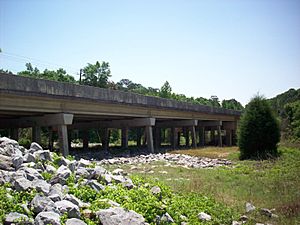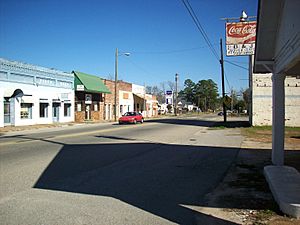Bill Sketoe facts for kids

William Sketoe, Sr. (born June 8, 1818 – died December 3, 1864) was a Methodist minister from Newton, Alabama. He was killed in Newton on December 3, 1864. This event led to one of Alabama's most famous ghost stories.
Local stories often say he was killed for leaving the Confederate Army. However, other records suggest he was killed for helping people who supported the Union. No matter the reason, a small hole was dug under his feet during the hanging. This was done to make space for his tall body. This hole became known as "the hole that won't stay filled." People said the hole never disappeared, even after being filled many times. It kept its size for 125 years.
Sketoe's story became a popular part of Southern folklore. It was made famous by Alabama author Kathryn Tucker Windham in her book 13 Alabama Ghosts and Jeffrey. The place where he was hanged was a local tourist spot for many years. People still visit it today, even though the hole disappeared recently due to flooding. Now, the site is under the Alabama Highway 134 bridge over the Choctawhatchee River. A monument to Sketoe stands nearby.
Contents
Who Was William Sketoe?
While some parts of Bill Sketoe's story are hard to confirm, we know he lived in Newton, Alabama, before the Civil War. He was killed there on December 3, 1864. The main source for his tale is Kathryn Tucker Windham's book, which shares the legend passed down in Newton.
His Life in Newton

According to the legend, Sketoe was born in Madrid, Spain on June 8, 1818. He came to Dale County, Alabama as a boy with his father. People in the community seemed to like him. He chose to become a minister.
As a circuit rider (a traveling minister) in the Wiregrass area, Sketoe met and married Sarah Clemmons. They had eight children together. The story says Sketoe joined the Southern Army during the Civil War. However, government records do not show him serving in any Confederate unit. The legend says he served until the fall of 1864. He then heard his wife was very sick and decided to go home.
The Mystery of the Hole
Sketoe's death caused a lot of talk in Newton. People soon noticed that the hole dug for his hanging never went away. It stayed about thirty inches wide and eight inches deep. Even when people filled it with trash or dirt, it would be empty again, sometimes within hours.
Campers said they put their tents right over the hole after filling it with dirt. But they would wake up the next morning to find it empty. All of this made Sketoe's story a legend. It was later written about in Windham's book, bringing many visitors to Newton to see "Sketoe's hole."
One local person, Mary Fleming, who lived in Dale County after the war, saw the hole many times. She believed there was a natural reason for it. She said Sketoe's friends, like Wash Reynolds, secretly kept it clean. They wanted people to think it was something supernatural. But Reynolds strongly denied this. He said he knew nothing more about the hole than anyone else.
What Happened to the Hole?
In 1979, a new highway bridge was built over the spot where Sketoe was hanged. His hole ended up under this new bridge. In 1990, there was a flood. Workers had to bring in large rip-rap rocks to make the river bank stronger. The hole was covered with tons of these rocks.
Even though the hole itself cannot be seen anymore, the site is still popular. Visitors and people who study the paranormal still come to see it. In 2006, members of the Sketoe family and officials from Newton put up a monument near the site of his death. It tells a short version of Windham's story.

